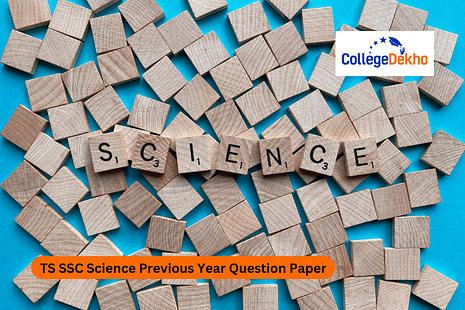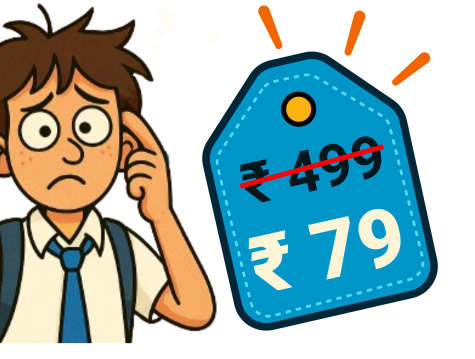

Never Miss an Exam Update
TS SSC Science Previous Year Question Papers are listed here to be downloaded in a PDF format. Science paper will be conducted two times that is paper 1 and paper 2. The theory paper will be conducted for 40 marks. Students will be given 2 hours and 45 minutes to complete each paper. Each paper is divided into two parts. Part A will consist of three sections. These sections will consist of very short answer-type questions and long answer-type questions. Part B will consist of MCQs and each question will carry a half mark. Students are expected to answer all the questions in part B because there will be no internal choice. Part A will consist of internal choices, and the students must answer the questions according to the instructions on the question paper.
TS SSC Time Table 2025 will be released very soon so the students must complete the TS SSC Science Syllabus 2024-25 as soon as possible to carry forward their revision using the sample papers and the previous year's question papers. Check out more information about the TS SSC Science Previous Year Question Paper here.
TS SSC Latest Updates
March 17, 2025: Telangana board is going to conduct the TS SSC exams 2025 from March 21, 2025 to April 04, 2025. The students should perform well and will be able to check the result in the last week of April 2025 on its official website.
TS SSC Science Previous Year Question Paper: PDF
Check out the direct PDF links of the TS SSC Science Previous Year Question Papers here. Make sure to solve as many question papers as needed to get familiar with the format of the question papers and also the commonly asked topics by the Directorate of Government Examinations, Telangana.
Academic Year | Download Link |
|---|---|
2019 Paper 1 | |
2019 Paper 2 | |
2018 Paper 1 | |
2018 Paper 2 | |
2017 Paper 1 | |
2017 Paper 2 | |
2016 Paper 1 | |
2016 Paper 2 | |
2015 Paper 1 | |
2015 Paper 2 |
How To Download TS SSC Science Previous Year Question Paper?
The official website will not host the TS SSC Science Previous Year Question Paper but will upload the latest Telangana Class 10 Sample Paper 2024-25 . Students can follow the simple steps given below to download the sample papers when uploaded on the official website:
- Step 1: You will first have to visit the official website of the Directorate Of Government Examinations Telangana at bse.telangana.gov.in
- Step 2: The home page will open on your screen where you have to click on the option called Telangana Class 10 Sample Paper 2024-25
- Step 3: On the new page, you have to now click on the Science option to download the question paper.
Why Practice TS SSC Science Previous Year Question Paper?
Practicing the previous year's question papers will have the students in many ways. Check out some of the reasons why you should solve the question papers as soon as possible:
- Question papers will help the students to get familiar with the TS SSC Science exam pattern and also the syllabus as uploaded on the official website of DGE Telangana.
- Solving the question paper is one of the easiest ways to evaluate yourself based on the preparations that you have made.
- Once you evaluate yourself and you come across your weaknesses you can easily work on the weaknesses. Students can focus on one topic at a time using the evaluation method.
- Question papers will help you to study systematically. You must pick up the question papers only after you have completed your syllabus to be confident when solving them.
- Solving the question papers and seeing great results will help the students to boost their confidence.
Steps to Solve TS SSC Science Previous Year Question Paper
While solving the TS SSC Science Previous Year Question Papers, the steps mentioned below can be followed to perform well in the exams. With the help of these tips, it will be easy for the students to score high marks.
Focus on Short Question First - When starting with the TS SSC Science question paper , students should solve the short questions first. This will take less time and save more time for long questions.
Read Questions Twice to Understand Better - The students should first focus on understanding the questions. Reading the questions multiple times will help them understand the complete meaning of it. This will enable them to write correct answers.
Follow the Timeline - When solving the questions, students should aim at completing the questions within the exam duration. All the questions should be attempted in the time limit prescribed by the board. In addition to answering the question, students should reserve some time for revision of answers.
Practice Drawing Diagrams -
For Science questions, it is important to draw well-labelled diagrams with long answers. The diagrams can help students in scoring good marks.
Also Read -
TS SSC Marksheet 2025
TS SSC Science Syllabus 2024-25
Students must have perfect knowledge of the science syllabus to prepare well for the exam. Check out the syllabus for both the papers from the table given below:
Physical Science
Unit | Sub - Topics |
|---|---|
|
Spherical mirrors, convex and concave mirrors Pole, Focus, Centre of curvature, principle axis, Radius of curvature, Focal length Formula for spherical mirrors – sign convention Application of reflection – Solar Cooker, etc. |
|
Chemical equations – writing chemical equations, skeletal chemical equations, balancing chemical equations Writing symbols of physical states, Heat changes, gas evolved and precipitate formed Interpreting a balanced chemical equation |
|
What do acids have in common? What do bases have in common? Do Acids produce Ions only in Aqueous Solution? Reaction of Acid, Base with water Strength of Acid or Base – pH scale Importance of pH in everyday life Salts Chemicals from common salt |
|
Lenses Rules for Ray diagram Images formed by the lenses Formula derived for thin lenses Focal length of lens depends on the surrounding medium Lens maker formula |
5. Human eye and colourful world |
Structure of human Eye – Focal length of human Eye lens, accommodation Common accommodation defects of vision – Myopia, Hypermetropia, presbyopia Prism Scattering of light |
6. Structure of atom |
Electromagnetic Spectrum Bohr’s model of a Hydrogen atom and its limitations Quantum mechanical model of an Atom Electronic Configuration of elements in their atoms nl rule, Energies of electronic energy levels (n+l) rule; Aufbau Principle, Pauli’s principle, Hund’s Rule of maximum multiplicity, Stable configurations |
7. Classification of Elements – The Periodic Table |
Doberieners Triads – Limitations Newland’s law of Octaves Mendeleev’s Periodic Table (Periodic law, Achievements & Limitations) Modern Periodic Table. |
8. Chemical Bonding |
Electronic theory of Valence by Lewis and Kossel Ionic and Covalent bonds: examples with Lewis Dot formulae The arrangement of Ions in Ionic compounds Factors affecting the formation of cation and anion Shapes, bond lengths and bond energies in molecules Valence shell electron pair repulsion theory Valence bond theory Properties of Ionic and Covalent Compounds |
9. Electric Current |
Potential difference How a battery or a cell works Ohms law and its limitations, resistance, specific resistance, factors influencing resistance, electric shock Electric Circuits Electric power Safety fuses |
10. Electromagnetism |
Magnetic field – field lines Magnetic field due to currents Magnetic force on moving charge and current carrying wire Electric motor Electromagnetic induction – Faraday’s law (including magnetic flux) – Lenz law Generators and Alternating – Direct Currents |
11. Principles of Metallurgy |
Extraction of metals from the Ores – activity series and related metallurgy, flow chart of steps involved in the extraction of metals from ore. Corrosion – Prevention of Corrosion Important Processes used in metallurgy Flux Furnace |
12. Carbon and its compounds | Introduction of Carbon compounds Promotion of an Electron – Bonding in Carbon including Hybridization Allotropes of Carbon Versatile nature of carbon Hydrocarbons Bonding of carbon with other elements Isomerism Homologous series Nomenclature of carbon compounds Chemical properties of carbon compounds Important carbon compounds Esterification reactions Soaps – Saponification, Micelles |
Biological Science
Units | Chapters |
|---|---|
Nutrition | Life process- Introduction Photosynthesis Nutrition in organisms Digestion in human beings Healthy points about oesophagus Malnutrition |
Respiration |
Respiratory system in human being Cellular respiration Respiration – Combustion Evolution of gaseous exchange Plant respiration |
Transportation |
Cardiac cycle Lymphatic system Evolution of transport system Blood pressure Blood clotting Transportation in plants |
Excretion | Excretion in Human beings Excretory system Structure of Nephron Formation of urine Dialysis – Artificial kidney Accessory Excretory organs in human being (Lungs, skin, liver large intestine) Excretion in other organisms Excretion in plants Excretion, Secretion |
Coordination | Stimulus and response Integrated system – Nerves coordination Nerve cell structure Pathways from stimulus to response Reflex arc Central nervous system Peripheral nervous system Coordination without nerves Autonomous nervous system Coordination in plants – Phytohormones |
Reproduction | Growth of bacteria in milk. Asexual reproduction Sexual reproduction Sexual reproduction in plants Cell division – Cell cycle Reproductive health – HIV/ AIDS |
Coordination in Life Processes | Hunger Relation between taste and smell Mouth – a mastication machine Passage of food through oesophagus Stomach is mixer |
Heredity and Evolution | New Characters – variation Experiments conducted by Mendal (F1 generation,F2 generation), Mendel’s Laws Parents to offsprings Evolution Origin of species Evolution – Evidences Human Evolution |
Our Environment | Ecosystem – Food chain Human activities – Their effect on ecosystem Biological pest control measures |
Natural resources | Case study – Agricultural land (past and present) Case study – Water management Water resources in the Telugu States Natural resources around us Forest Renewable resources Fossil fuels Conservation, Reduce, Reuse, Recycle, Recover |
Also Read:
TS SSC Result 2025
TS SSC Science Previous Year Question Paper is a great tool to prepare for the board exams. Students can easily understand the paper pattern and syllabus by downloading the official question papers.
FAQs
Students can visit the official website of the Telangana board to download the previous year question papers for Science. They can start solving the question papers one by one and get introduced to the variety of questions.
The students with a good understanding of the subject and ability to write better answers can easily score high marks in the TS SSC Science exam. They will have to attempt MCQs, very short questions, short questions, and long questions in the Science exam.
It is important for the students to first complete the syllabus and then pick up the TS SSC Science Previous Year Question Paper. If you pick up the question papers without any knowledge of the topics and the chapters then you will have a hard time understanding the questions. This will lead to inefficient revision which will be not of any help during the board exam.
Students can download the TS SSC Science Previous Year Question Paper for 2019 by clicking on the PDF link given here. The latest question paper will be uploaded as soon as it is released by the Telangana board authorities in a PDF format.
Two papers are included in the Science exam so students have to appear for paper 1 and paper 2 accordingly. Each paper of the TS SSC Science Previous Year Question Paper will be divided into two parts. Part A will consist of three sections which will have different types of questions and internal choices will be provided in each section along with the instructions to be followed when answering these questions. Part B will consist of 10 MCQs for half mark each to be answered without any internal choice.
Students can click on the direct link given here to download the TS SSC Science Previous Year Question Paper. The official model papers are also available on the website of the Telangana Board to be downloaded in a PDF format. The model paper will be structured based on the latest exam pattern.
Students who have completed their study sessions for the board exams and now want to revise can download the TS SSC Science Previous Year Question Paper. Make sure that you are solving enough question papers so that you have proper information about the latest exam pattern and the syllabus.
Was this article helpful?
















